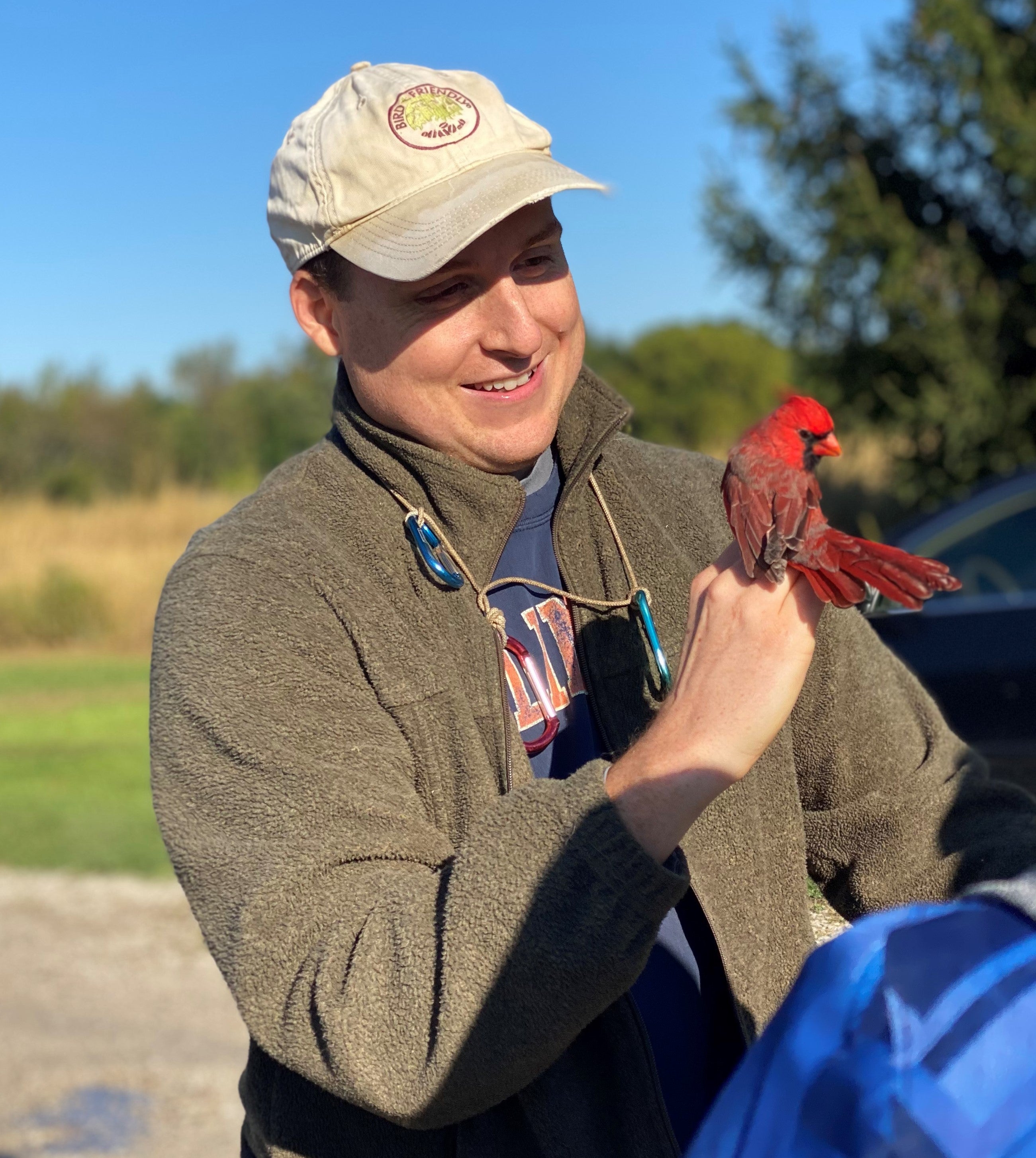Focus on the Future: Todd Jones
Postdoctoral fellow Todd Jones holds three juvenile dickcissels that are close to fledging.
Since middle school, I knew I wanted to work with animals in some capacity. Growing up in Columbus, Ohio, my family vacations weren’t to theme parks, they were to national parks and wildlife refuges; I therefore grew up with a great appreciation for and interest in nature.
When I was a freshman in college, my family went on vacation to the Upper Peninsula of Michigan. It was there I saw a boreal chickadee and that experience piqued my interest in birds. When I got back to school after the break, I started contacting every TA in the Ohio State biology department to learn who was doing research on birds. Fortunately for me, Amanda Rodewald was leading an avian research lab at the time and gave me my first research opportunity. The first time I went into the field and one of her graduate students handed me a female northern cardinal, I was hooked.

Jones credits an experience with a northern cardinal for solidifying his career path.
This drove me to pursue my own undergraduate research thesis under Rodewald’s mentorship. I graduated in 2009 with a bachelor's degree in zoology, with research distinction. Rodewald and her graduate students encouraged me to get more field experience before going to graduate school, so I worked as many field technician jobs as I could fit in over a four-year span. The tech jobs took me across the United States, and even to Canada, the Caribbean and Central and South America. They helped me to build field research techniques that I use to this day.
In 2012, I started my master’s degree at the University of Illinois Urbana-Champaign working with Jeffrey Brawn and Michael Ward. I conducted research on dickcissels in the grasslands of east-central Illinois, finding and banding fledgling birds so we could track their survival, habitat use and movements. While we were banding the nestlings, I noticed there was a lot of variation in how feathered the fledglings were and the length of their flight feathers. These observations led me to wonder if the length and number of feathers impacted their survival during the subsequent post-fledging period (i.e., the time after they leave the nest).
To see if this was the case, I took photographs of the birds to get estimates of wing development for nestlings before they left the nest and placed miniaturized radio-tags on their backs to track their survival and movements. Sure enough, over several seasons we saw a strong correlation between wing development and survival. Having observed this trend in one species, this research led to my dissertation and eventually my doctoral work, where I examined whether there were similar trends within and among ten different songbird species in Illinois. With an expanded dataset, I found not only do feather differences dictate survival rates within an individual species, but they dictate survival rates among species as well. We also included brown-headed cowbirds in the study, which are a brood parasitic species who lay their eggs in other birds' nests to be raised by the host species. Fascinatingly, we found the same patterns in the cowbirds as we did in the host species they parasitized.
My research helped to reinforce that the post-fledging period is a critical life stage for birds; it’s a key steppingstone to everything else they do in life. The post-fledging period has large implications for a species demographics, life history evolution and whether a species may persist into the future. It’s also one of the less studied topics in ornithology, so it’s a wide-open field with so much to pursue.

Jones places small metal bands on the legs of juvenile birds in order to study their progression as they fledge.
Once I finished my Ph.D., I got a postdoctoral fellowship at Texas A&M University-San Antonio, where I worked with Jennifer Phillips to examine the impacts of urbanization on birds; our research suggests birds in more urban, light polluted areas may have smaller eyes. During this postdoc, I connected with a peer and former boss of mine during my tech days, Sara Kaiser, who is a research ecologist at the Cornell Lab of Ornithology and who leads a field ornithology program at the Hubbard Brook Experimental Forest, in the White Mountains of New Hampshire. Through Sara, I met Scott Sillett, a research biologist and the head of the Smithsonian Migratory Bird Center, and Michael Webster, a professor and director of the Macauly Library at the Cornell Lab of Ornithology. It came up that there’d never been any post-fledging research at the Hubbard Brook Experimental Forest, so it was a perfect fit for me to begin studying fledgling black-throated blue warblers in the forest and compare them to other species. This led to my current postdoctoral position at the Smithsonian Migratory Bird Center.
Throughout my early career in ornithology, I have seen firsthand that when you connect birds with people, they can become amazing ambassadors of the wildlife world. Birds also reflect how well an ecosystem is doing, especially regarding environmental change resulting from urbanization and climate change. One of the overarching questions driving my current research is, “how are birds responding to changes in seasonality, such as earlier springs and later falls brought on by climate change?” And since very few people have studied this, we hope the post-fledging research at Hubbard Brook can help move the needle on this topic. Ultimately, what’s good for the birds is good for humans, so this research has important implications for people as well.
My advice to future scientists is for them to be open-minded about getting field experience. Whether it’s field technician jobs or volunteering, just get into the field to see what it is like. Whether you work with birds, lizards or mammals, it’s good to get hands-on experience so you can figure out what you’re interested in and then pursue that.